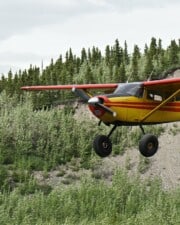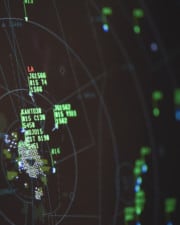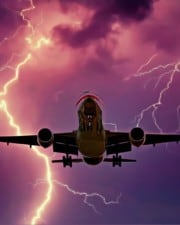Few things strike more fear into the hearts and minds of pilots than the dreaded flat spin. But what exactly is a flat spin, what causes it, and how do you recover from it?
A flat spin is a dangerous flight condition that can be impossible to recover from. Thankfully, it’s not likely to happen on any routine flight. It occurs when the plane has no forward airspeed as it spins towards the ground around its vertical axis.
What is a Spin?
A spin occurs when the aircraft is stalled, but one wing is more severely stalled than the other. To understand precisely what this means, you’ll need to understand a few basic terms and some aerodynamics.
A stall occurs when the angle of attack gets too high. The angle of attack is the angle at which the wings of a plane meet the relative wind. As the wind comes at a steeper and steeper angle of attack, air can no longer smoothly flow over the wing’s surface. When that happens, the wing suddenly produces a lot less lift than it did before it stalls.
With the precipitous drop in the amount of lift the wing makes, it is likely that it no longer makes enough lift to keep the aircraft aloft. It’s important to realize that a stall does not mean that a wing is no longer making any lift at all. It simply means that the wing is no longer working efficiently, and the amount of lift it makes has been severely reduced.
As the angle of attack continues to get higher beyond that critical angle of attack where a stall occurs, the amount of lift created continues to dwindle. So there are varying degrees to which an airplane’s wing can be stalled.
As an aircraft nears a stall, a yawing or rolling movement can cause enough turning force to stall one wing before the other. If the aircraft continues to fly deeper into the stall, the condition of having differential lift across the wings will aggravate the stall into a spin.
During a spin, the aircraft usually pitches down and begins spinning in a corkscrew-shaped spiral toward the ground. The forward airspeed is very slow since the aircraft is stalled. But the sink rate towards the ground can be very fast, and the rotation rate can be violent and disorienting to the pilot.
Types of Spins
Stalls can be divided roughly into three categories — upright, inverted, and flat.

Upright Spins
Upright spins are like those described above. The airplane sinks toward the ground at a high rate of speed and rotates around the more-stalled wing at a high rate. But overall, the aircraft is in a normal flight attitude.
Inverted Spins
Inverted spins are exactly like they sound — upside-down.
Flat Spins
Flat spins are the worst and most dangerous type of spin. In a flat spin, the aircraft has no forward airspeed. It spins around its vertical axis as it sinks straight towards the ground.
With no forward airspeed at all, the flight controls are not effective. The pilot effectively has no way to correct for the spin, and it is possible (and perhaps likely) that it cannot be corrected.
What Causes a Flat Spin?
The type of spin a plane enters depends on what happened when the condition started and how the aircraft was loaded. Weight and balance plays a pivotal role in stalls and spins.
A properly loaded aircraft will be nose-heavy without any inputs from the flight controls. The only thing that keeps the nose from sinking during routine flight is the tail-down force normally created by the horizontal stabilizer. If there is no air flowing over the stabilizer, the tail-down force will be non-existent, and the nose should sink.
The nose sinking should cause the airspeed to increase, thereby making a flat spin impossible. The airplane is designed to avoid this dangerous condition, and all the pilot has to do is get out of the way and allow the plane to recover.
But what if the pilot has ignored the proper loading of the plane? When adding weight to the plane, pilots must check that all of the forces remain within the safe flight envelope. During preflight planning, the pilot will determine the location of the center of gravity (CG).
If the CG is located too far forward, the aircraft’s nose will want to drop naturally. In this instance, the tail-down force made by the stabilizer and elevator might not be enough to correct for the heavy nose-down force made by a forward CG. The plane might not be able to rotate on takeoff. Or once airborne, the plane might enter a nose dive if the airspeed gets too low.
Alternatively, if the CG is located too far aft, the nose might want to pitch up. If left unchecked, the nose up force could cause a stall. If the plane stalls and has insufficient air flowing over the stabilizer and elevator controls, the pilot might not get the plane out of the stall.
If you combine this very bad situation with a turning force, you have the setup for an uncontrollable and unrecoverable flat spin.
Turning forces can come from the pilot’s controls, like the rudder or ailerons, or from the engine. The propeller on airplanes causes several twisting and turning forces that can exacerbate a stall or spin without caution.
How To Recover From a Flat Spin
The FAA teaches the acronym “PARE” to help pilots remember how to recover from a spin and spin recovery technique.
P – Power to idle
A – Ailerons neutral (control yoke centered)
R – Rudder opposite turn
E – Elevator forward

Power
As previously mentioned, the power from a propeller can exacerbate a spin. Pulling it to idle power can reduce the turning forces and give the pilot more time to recover.
Ailerons
Ailerons work by changing the angle of attack at the plane’s wingtips. In the middle of a spin, any use of the ailerons will make the spin worse. Remember, a spin occurs when one wing is more severely stalled than the other. Ailerons will make it even more stalled.
Rudder
With the ailerons removed from the equation, the rudder becomes the best tool the pilot has for controlling the flight direction. Plus, prop wash will keep the rudder functional at very low airspeed. By applying full rudder in the opposite direction, the pilot can stop the spin’s rotation.
Elevator
A spin is fundamentally an aggravated stall. The only way to recover from a stall is to reduce the angle of attack, and that is done by moving the control column forward. In a spin, this can seem a very unnatural thing to do since the aircraft’s nose is often pointed down. But it’s the only way to get out of the situation.
If the spin is inverted, you’d have to pitch up instead of down.
Flat Spin Recovery Chances
Can a plane recover from a flat spin? The answer is – not always. And that’s precisely why flat spins are so dangerous.
The steps to try are the same as above. But if there is no forward airspeed, there is likely no airflow over the elevator to force the nose of the plane down.
If the standard attempts to get out of a spin don’t work, it’s time to rewrite the book. For a flat spin where nothing else is working, try adding power to make the elevator and the rudder more effective.
If that doesn’t work, time is running out. Did you wear a parachute? Does the plane have a CAPS parachute? I sure hope so – because time’s up.
Seriously, weight and balance is super important. Pilots — don’t leave the ground without double-checking it. There’s no reason for a properly loaded aircraft to enter a flat spin to begin with. And if it did ever get close to being in one, recovery should be easy. It’s only when flying “outside of the envelope” that it’s even a possibility.
Intentional Aerobatic Spins
Stunt pilots routinely perform stunts, including simulated flat spins, to wow the crowds. But these spins are fundamentally different than the spins described above. These spins are performed with the aircraft loaded very carefully within its limits.
To get a flat spin’s look and feel, power is used to flatten out the aircraft’s flight attitude during a normal upright spin. Even still, the forces that are put on the airframe, engine, and pilot are extreme during such a maneuver. Sometimes, the turn rate can be more than 400 degrees per second.
Stall and Spin Training
Pilots begin practicing stall entry and recovery techniques early in their flight lessons. Only by experiencing a stall can a pilot understand the steps they need to take to get out of one. And only by experiencing it can a pilot begin to identify the early warning signs of a stalling airplane. Ideally, this training keeps them out of trouble in the future.
The view from inside the plane is dramatically different during a stall than during a spin. Unfortunately, spin training is not required for most pilots in the US. Aerobatic pilots get a lot of practice, but many pilots have never spun a plane. A little bit of spin training is required for the flight instructor license, however.
There are many reasons for this lack of experience, not the least of which are the risks involved. Spins are demanding on aircraft, and only utility category planes are even approved for intentional spin maneuvers. Normal category planes are usually placarded as “Not Approved for Spins.”
It’s precisely this lack of physical practice that makes the book work important. Getting out of spins isn’t difficult — in a properly balanced aircraft, removing all pilot control inputs and putting the power to idle should get the plane to begin its recovery on its own.
But regardless of these factors, a pilot with a solid foundation of good stick-and-rudder skills shouldn’t have a problem with spins anyway. By maintaining proper airspeeds and flight profiles, the plane should never be anywhere near stalling.
And by recognizing a stall and instituting the proper recovery well in advance of the actual stall, a pilot should be even farther from a spin. And by having the aircraft correctly loaded before a flight, a pilot should have virtually no chance of entering an unrecoverable flat spin.
This is the perfect example of how pilots mitigate risk in flight for any number of factors. It’s never one thing that a pilot does that causes or doesn’t cause an accident. It’s a chain of choices that must be made to ensure the safe operation of an aircraft.
References ▾
Related Posts














